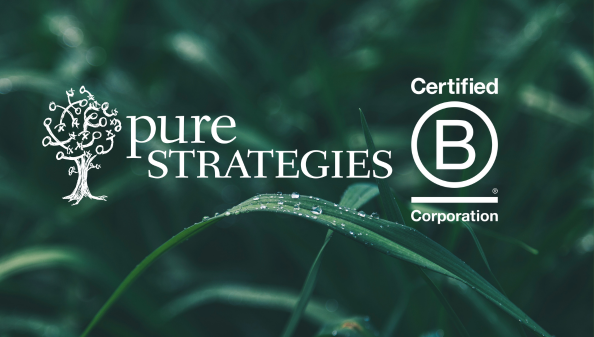Pure Strategies’ vision is to realize a net-zero, nature-positive, and safe and equitable world. Our work with companies and organizations are aimed to support that vision, including a shift to a more circular economy – one in which materials are recovered, used again, and do not become waste. That is why our team is engaged in efforts such as the U.S. Plastics Pact. As a U.S. Plastics Pact Activator, we commit to continue to help businesses transition to a more circular economy, such as increasing the use of post-consumer recycled (PCR) plastic in their packaging to reduce the use of virgin materials and capture the associated environmental and economic advantages, including a reduction in greenhouse gas (GHG) emissions.

The Ellen MacArthur Foundation’s New Plastics Economy: A Vision of a Circular Economy for Plastic highlights six elements of a circular economy for plastic. One key characteristic is that the use of plastic is fully decoupled from the consumption of finite fossil resources by reducing the use of virgin plastic and by increasing the use of recycled content. In 2020, plastic packaging contained an average of 7% PCR plastic content – plastic made from plastic bottles and containers recycled by consumers every day – and related, only 37% of plastics are currently recycled, reused, or composed, indicating that we have a long way to go.
Why Use PCR Plastic Packaging?
Increasing the use of PCR plastic content offers environmental and economic advantages that go hand-in-hand with supporting a circular economy. When companies increase the use of PCR plastic content, they reduce the demand for virgin materials in plastic packaging, decoupling it from the consumption of finite fossil resources. At the same time, they increase demand for recycled plastic, motivating the supply side to ramp up.
As detailed in the Sustainable Packaging Coalition’s Design for Recycled Content Guide and Ocean Conservancy’s Recommendations for Recycled Content: Requirements for Plastic Goods and Packaging, environmental benefits of using PCR plastic include reduced energy and water consumption, lower GHG emissions, and less plastic waste in landfills, incinerators, and the ocean. Replacing virgin plastic with recycled content can reduce GHG emissions by about half for PET plastic and by 65-70% for HDPE plastic.
Increasing the use of PCR plastic in packaging is also good for business. Business benefits include:
- Getting ahead of the curve. Companies that are prioritizing the increase of PCR plastic content in product packaging are well-positioned for the growing wave of laws requiring companies to increase PCR and extended producer responsibility (EPR) to eliminate, reduce, or pay for the recycling of single-use plastic packaging. California already requires that plastic bottles covered by the bottle deposit program contain at least 15% PCR and just passed a new law that includes an EPR program for plastic packaging. In Washington, plastic bottles must initially average at least 15% PCR by 2025 and gradually increase to 50% PCR by 2031. New Jersey will require rigid plastic containers to contain at least 10% PCR content and plastic beverage containers to contain at least 15%, rising incrementally over the years to 50% by 2036 and 2045, respectively.
- Enhancing brand loyalty and market share. Recycled content in product packaging increases brand loyalty, boosts sales, and creates new marketing opportunities, according to Plastics for Change. Almost two-thirds (64%) of consumers prefer to buy products in packaging with recycled content, and more than 70% are willing to pay more for sustainable packaging, according to the 2021 Global Buying Green Report.
How Are Companies Making Progress?
The 2025 goal of the U.S. Plastics Pact is an average of 30% recycled content or responsibly sourced bio-based content in plastic packaging. What are companies doing to make the shift? The Ellen MacArthur Foundation 2021 Global Commitment Progress Report and Circular Economy Growth Potential by Sector: Plastics and Packaged Goods detail the type of goals and actions top companies are taking. Below are a few examples of how our clients are making progress at different stages of their sustainable packaging journey.
- Explore: Perrigo Oral Care recently began tackling the packaging challenge by asking some big questions: How much plastic are we using? What type of plastic is it? Is it recyclable? Does it have recycled content? As a first step toward change, the company created a baseline that generated useful insights on the sustainability of their existing packaging.
- Define: TAZO, whose aim is to be a regenerative brand, assessed its impacts before developing bold packaging goals, including 100% recycled or sustainably-sourced, renewable packaging content by 2026. The company crafted a roadmap and refined its governance structure to catalyze progress toward meeting its goals.
- Activate: Walmart established a private brand plastic packaging goal of at least 17% PCR content globally by 2025. To help reach this goal, the company published a Recycling Playbook, a design guide that includes recommended PCR levels for packaging to be used by suppliers. FMI has also created a Sustainable Packaging Playbook, an industry guide to help retailers and suppliers develop sustainable packaging with a particular focus on recyclability, waste reduction, and circularity.
Start Closing the Loop
Our commitment is to continue to help companies advance a circular economy, including increasing their use of PCR plastic content from just 7% to reach the U.S. Plastics Pact goal of 30% by 2025. This step is vital to closing the loop and building a circular economy that reduces plastic pollution and results in significant benefits for the environment and economy.
To learn more about this crucial issue, explore the resources below. If you are ready to take action and need support, please reach out to us directly at: info@purestrategies.com.


